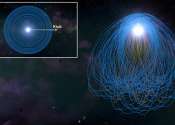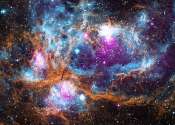Last update:
Astronomy news

REBELS-25 is a dynamically cold disk galaxy, observations find
An international team of astronomers has observed a high-redshift massive star-forming galaxy known as REBELS-25. They found that REBELS-25 is a dynamically cold disk galaxy. This finding was presented in a research paper ...

Report: 'Urgent' change needed to tackle bullying in astronomy and geophysics
"Urgent" action is needed to address an "insidious" and systemic bullying problem within the world of astronomy and geophysics, a report warns.
Astronomy
May 17, 2024
12
32

Hubble views cosmic dust lanes
Featured in this new image from the NASA/ESA Hubble Space Telescope is a nearly edge-on view of the lenticular galaxy NGC 4753. Lenticular galaxies have an elliptical shape and ill-defined spiral arms.
Astronomy
May 17, 2024
0
67

Astronomers detect rare neutral atomic-carbon absorbers with deep neural network
Recently, an international team led by Prof. Ge Jian from the Shanghai Astronomical Observatory of the Chinese Academy of Sciences conducted a search for rare weak signals in quasar spectral data released by the Sloan Digital ...
Astronomy
May 17, 2024
0
36

Data from MAXI J1820+070 shows Einstein was right about how matter plunges into a black hole
A team of astrophysicists from the University of Oxford, Newcastle University and the Institute of Astronomy, all in the U.K., working with a colleague from the University of Virginia, in the U.S., has found evidence showing ...

Q&A: Stellar insights—the Mauve mission's journey into the cosmos
In a quest to study the variety of stars in our galaxy, the Mauve mission has emerged to provide a stronger understanding of the characteristics of stars—including their magnetic activity, flare evolution, and influence ...
Astronomy
May 16, 2024
0
27

How NASA tracked the most intense solar storm in decades
May 2024 has already proven to be a particularly stormy month for our sun. During the first full week of May, a barrage of large solar flares and coronal mass ejections (CMEs) launched clouds of charged particles and magnetic ...
Astronomy
May 16, 2024
0
72

A new space mission may help physicists answer 'hairy' questions about black holes
Physicists consider black holes one of the most mysterious objects that exist. Ironically, they're also considered one of the simplest. For years, physicists like me have been looking to prove that black holes are more complex ...
Astronomy
May 16, 2024
0
21

Webb detects most distant black hole merger to date
An international team of astronomers have used the NASA/ESA/CSA James Webb Space Telescope to find evidence for an ongoing merger of two galaxies and their massive black holes when the universe was only 740 million years ...
Astronomy
May 16, 2024
0
65

Into the abyss: Understanding black hole formation through natal kicks and neutrino emission
A new study in Physical Review Letters explores the conditions of black hole formation from dying stars, particularly the role of neutrino-induced natal kicks in the formation process.

Three new RR Lyrae variable stars discovered
Using the Lulin One-meter Telescope (LOT), astronomers have observed a newly detected candidate ultra-faint dwarf galaxy known as Virgo III. As a result, they discovered three new RR Lyrae variable stars in the vicinity of ...

Video: SOHO's view of the 11 May 2024 solar storm
Over the weekend of 10–12 May 2024, Earth was struck by the largest solar storm in more than a decade. While many of us enjoyed colorful auroras lighting up Earth's protective atmosphere, spacecraft had to endure being ...
Astronomy
May 15, 2024
0
15

Hubble views the dawn of a sun-like star
Looking like a glittering cosmic geode, a trio of dazzling stars blaze from the hollowed-out cavity of a reflection nebula in this new image from NASA's Hubble Space Telescope. The triple-star system is made up of the variable ...
Astronomy
May 15, 2024
0
74

Gravitational lenses could pin down black hole mergers with unprecedented accuracy
Gravitational wave astronomy has been one of the hottest new types of astronomy ever since the LIGO consortium officially detected the first gravitational wave (GW) back in 2016. Astronomers were excited about the number ...
Astronomy
May 15, 2024
1
30

Astronomers discover merging twin quasars
Using the Subaru Telescope in Hawaii, astronomers have detected a pair of merging quasars at a high redshift, as part of the Hyper SuprimeCam (HSC) Subaru Strategic Program (SPP) survey. The serendipitous discovery is reported ...

Astronomers find the biggest known batch of planet ingredients swirling around young star
Astronomers have discovered what they believe is the biggest known batch of planet-making ingredients swirling around a young star.
Astronomy
May 14, 2024
0
1161

Some clever ways to search for primordial black holes
Primordial black holes (PBHs) have recently received much attention in the physics community. One of the primary reasons is the potential link to dark matter. In effect, if PBHs can be proven to exist, there's a very good ...
Astronomy
May 14, 2024
3
43

Researchers chart Orion Nebula like never before
Star and planet formation is a messy affair. It starts with the gravitational collapse of a gigantic cloud of gas and dust, which simultaneously produces massive stars, whose intense radiation field creates a harsh environment, ...
Astronomy
May 14, 2024
0
87

Supernova SN 2023fyq exhibited long-lasting pre-explosion activity, observations show
An international team of astronomers have performed photometric and spectroscopic observations of a Type Ibn supernova, known as SN 2023fyq. Results of the observations campaign, published May 7 on the pre-print server arXiv, ...

Three stars circling the Milky Way's halo formed 12 to 13 billion years ago
MIT researchers, including several undergraduate students, have discovered three of the oldest stars in the universe, and they happen to live in our own galactic neighborhood.
Astronomy
May 14, 2024
0
94
Other news

A model outlining the microscopic origin of black hole entropy

Can coal mines be tapped for rare earth elements?

By listening, scientists learn how a protein folds

Webb Telescope offers first glimpse of an exoplanet's interior

Webb cracks case of inflated exoplanet

Genes provide hope for the survival of Arabia's last big cat

Exploring extremes in the search for life on Mars






























































